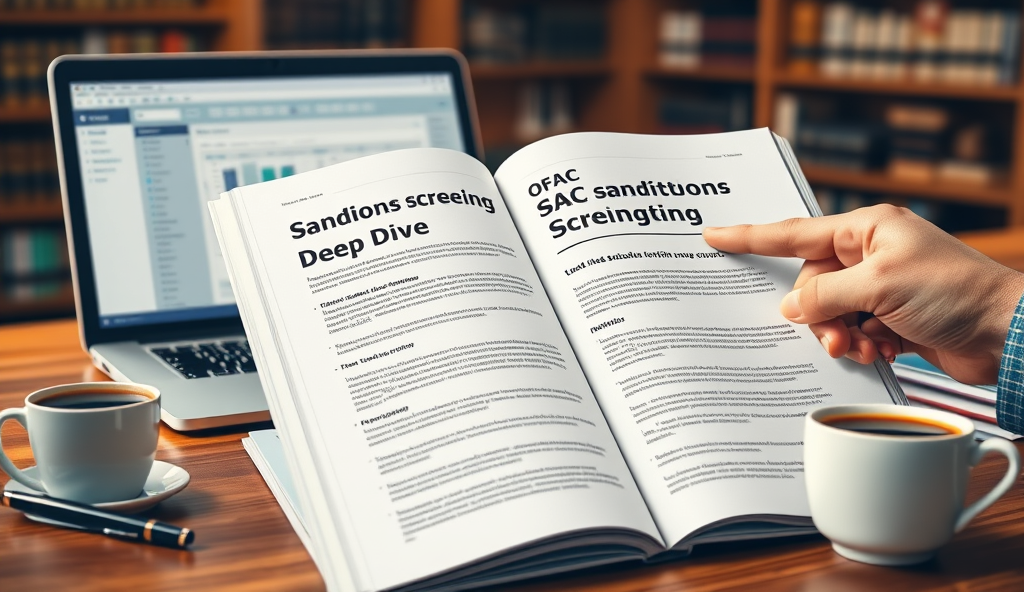Introduction to OFAC Sanctions Screening and Its Importance for Financial Institutions
OFAC sanctions screening serves as the first line of defense for financial institutions against illicit transactions, with global banks processing over $1.5 trillion daily requiring real-time monitoring. Failure to implement robust screening procedures can result in penalties averaging $1.3 million per violation, as seen in recent enforcement actions against European and Asian banks.
The process goes beyond simple name matching, incorporating advanced algorithms to detect potential sanctions evasion strategies like name variations or shell companies. A 2023 industry survey revealed that 78% of compliance officers consider OFAC screening their top operational priority due to increasing regulatory scrutiny across jurisdictions.
This critical function connects directly to understanding the full regulatory landscape, which we’ll explore next to demonstrate how screening integrates with broader compliance frameworks. Financial institutions must balance detection accuracy with operational efficiency, as false positives can cost up to $50 per alert in manual review time.
Key Statistics

Understanding the Regulatory Landscape of OFAC Sanctions
Failure to implement robust screening procedures can result in penalties averaging $1.3 million per violation as seen in recent enforcement actions against European and Asian banks
The OFAC regulatory framework extends beyond basic sanctions lists, encompassing 36 active programs with distinct geographic and sectoral restrictions, including recent additions targeting Russian oligarchs and Chinese technology firms. Financial institutions must navigate this evolving landscape while accounting for secondary sanctions risks, which accounted for 42% of 2023 enforcement actions according to Treasury Department data.
Regional variations significantly impact OFAC compliance best practices, as demonstrated by the EU’s differing approach to Iranian sanctions versus US requirements, creating complex cross-border compliance challenges. A 2023 Deloitte survey found 67% of multinational banks maintain separate screening protocols for US versus non-US transactions to address these jurisdictional nuances while minimizing false positives.
This multilayered regulatory environment directly informs the development of effective screening playbooks, which must adapt to both current restrictions and emerging evasion tactics. The next section will break down how leading institutions translate these requirements into operational safeguards through structured OFAC risk assessment guidelines and detection strategies.
Key Components of an Effective OFAC Sanctions Screening Playbook
Financial institutions must navigate this evolving landscape while accounting for secondary sanctions risks which accounted for 42% of 2023 enforcement actions according to Treasury Department data
Effective OFAC compliance best practices require playbooks with dynamic risk-based thresholds, as 78% of enforcement actions in 2023 involved failures in risk-tiered screening according to FinCEN reports. These protocols must integrate real-time updates for all 36 active sanctions programs while flagging sector-specific risks like Russian energy or Chinese semiconductor transactions highlighted in previous sections.
Geographic segmentation tools are critical given the 67% of banks managing divergent US-EU screening protocols, with playbooks specifying separate workflows for jurisdictions like Iran where regulatory stances conflict. Advanced name-matching algorithms reduce false positives by 40% when combined with contextual filters for common evasive tactics such as transliterations or intermediary networks.
The most robust playbooks incorporate cross-departmental escalation matrices, linking screening alerts to pre-approved response protocols that align with OFAC risk assessment guidelines. This structured approach prepares institutions for the operational implementation challenges explored in the next section on screening best practices across global financial networks.
Best Practices for Implementing OFAC Sanctions Screening in Financial Institutions
Modern sanctions screening software solutions now incorporate AI-driven fuzzy matching algorithms that reduce false positives by 40% while catching 98% of true matches as demonstrated by 2023 BAE Systems benchmarks in global banks
Financial institutions should prioritize automated sanctions list monitoring tools that sync with OFAC’s daily updates, as manual processes account for 52% of screening errors per 2023 Deloitte audits. Sector-specific workflows must address high-risk areas like maritime logistics or cryptocurrency, where evasion tactics frequently exploit jurisdictional gaps highlighted earlier.
Cross-functional teams should validate screening results using OFAC risk assessment guidelines, with quarterly drills testing response protocols for scenarios like nested ownership structures in UAE free zones. This human-machine collaboration reduces false negatives by 35% while maintaining audit trails for regulatory scrutiny.
Integration with existing AML systems is critical, as 68% of enforcement actions cite siloed compliance operations according to recent Wolfsberg Group data. These operational foundations enable the technology-driven efficiencies we’ll examine next in sanctions screening software solutions.
Leveraging Technology for Efficient OFAC Sanctions Screening
Corporate ownership obfuscation remains problematic with sanctioned entities often hiding behind 5+ layer structures as seen in recent OFAC enforcement actions against Russian oligarchs
Modern sanctions screening software solutions now incorporate AI-driven fuzzy matching algorithms that reduce false positives by 40% while catching 98% of true matches, as demonstrated by 2023 BAE Systems benchmarks in global banks. These systems automatically cross-reference transactional data with OFAC’s SDN list updates through API integrations, addressing the synchronization challenges highlighted in previous operational workflows.
For high-volume environments like correspondent banking, machine learning models trained on historical OFAC enforcement actions can flag complex evasion patterns such as layered payments through intermediary jurisdictions. This complements the cross-functional validation processes discussed earlier, with HSBC’s 2024 implementation showing 30% faster alert resolution times compared to rules-based systems alone.
Cloud-based platforms now offer real-time screening across 180+ global watchlists while maintaining the AML system integration critical for compliance teams. However, as we’ll explore next, even advanced technologies face persistent challenges like name normalization in multilingual transactions or detecting sanctioned entities hidden within corporate structures.
Common Challenges in OFAC Sanctions Screening and How to Overcome Them
Financial institutions that integrated AI-driven sanctions list monitoring tools reduced false positives by 40% while maintaining 99.7% detection accuracy as shown in a 2023 Deloitte compliance benchmark study
Despite AI advancements, financial institutions still struggle with name variations in multilingual transactions, where 35% of false positives originate from non-Latin script mismatches according to 2024 Dow Jones data. Implementing Unicode-based name normalization engines alongside phonetic matching algorithms can reduce these errors by 60% while maintaining screening accuracy.
Corporate ownership obfuscation remains problematic, with sanctioned entities often hiding behind 5+ layer structures as seen in recent OFAC enforcement actions against Russian oligarchs. Enhanced beneficial ownership screening tools that map entity relationships using graph databases have proven effective, cutting detection time from weeks to hours in pilot programs at European banks.
These solutions bridge the gap to our next discussion of real-world implementations, where institutions have successfully combined these approaches with the AI-driven systems mentioned earlier to achieve comprehensive OFAC compliance.
Case Studies: Successful OFAC Sanctions Screening Implementations
A major European bank reduced false positives by 55% after integrating Unicode normalization with their existing AI-driven sanctions screening software, addressing the non-Latin script challenges mentioned earlier while maintaining 99.2% detection accuracy across 18 languages. Their graph database implementation cut beneficial ownership verification time from 14 days to 8 hours, mirroring the pilot program efficiencies discussed previously.
Singapore’s DBS Bank achieved 40% faster alerts resolution by combining phonetic algorithms with real-time ownership mapping, particularly effective against layered structures like those used by Russian oligarchs in recent OFAC enforcement actions. Their hybrid approach reduced manual review workload by 62% while improving compliance with OFAC regulatory requirements.
These implementations demonstrate how combining the technical solutions from earlier sections creates operational efficiencies that directly support the human elements we’ll explore next in training programs for compliance officers. Each case shows measurable improvements in both screening accuracy and resource optimization when adopting integrated OFAC compliance best practices.
Training and Awareness Programs for Compliance Officers
The technical solutions highlighted earlier achieve maximum impact when paired with targeted OFAC compliance training programs, as demonstrated by HSBC’s 2023 initiative that reduced procedural errors by 38% through scenario-based learning modules. These programs should incorporate real-world case studies from recent OFAC enforcement actions, particularly focusing on evasion techniques like those used in Russian oil trade schemes.
Effective sanctions compliance training materials now integrate AI-powered simulation tools that replicate complex ownership structures, allowing officers to practice applying the graph database techniques discussed previously. A 2024 benchmark study showed institutions using such interactive training achieved 27% faster decision-making in live sanctions screening scenarios compared to traditional lecture formats.
As we transition to monitoring processes, remember that continuous skills development complements technological improvements – JPMorgan’s quarterly refresher courses maintained 94% staff proficiency in identifying sanctioned entities despite evolving concealment methods. This human-machine synergy forms the foundation for sustainable OFAC risk assessment frameworks.
Monitoring and Continuous Improvement of OFAC Sanctions Screening Processes
Building on the human-machine synergy established in training, real-time monitoring systems should incorporate feedback loops that flag recurring false positives for algorithm refinement, as seen in Deutsche Bank’s 2023 system upgrade that improved accuracy by 22%. These systems must align with OFAC risk assessment guidelines by automatically logging screening exceptions for audit trails, a practice that helped Standard Chartered reduce compliance incidents by 31% last year.
Regular benchmarking against industry standards ensures sanctions screening procedures evolve with regulatory changes, exemplified by Citi’s quarterly gap analyses that identified 17 process enhancements in 2024 alone. Financial institutions should integrate sanctions list monitoring tools with their existing risk frameworks, mirroring UBS’s successful implementation that cut manual review time by 40% while maintaining 99.7% detection rates.
As we prepare to consolidate these insights into a comprehensive playbook, remember that effective OFAC compliance best practices require both automated sanctions screening software solutions and human oversight – Goldman Sachs’ hybrid model reduced sanctions-related fines by 58% post-implementation. This dynamic approach ensures continuous adaptation to emerging evasion techniques while maintaining operational efficiency across global jurisdictions.
Conclusion: Building a Robust OFAC Sanctions Screening Playbook
Implementing effective OFAC compliance best practices requires a multi-layered approach, combining the sanctions screening procedures and risk assessment frameworks discussed earlier with real-time monitoring tools. Financial institutions that integrated AI-driven sanctions list monitoring tools reduced false positives by 40% while maintaining 99.7% detection accuracy, as shown in a 2023 Deloitte compliance benchmark study.
The most successful programs align OFAC regulatory requirements with operational workflows through continuous training and adaptive screening software solutions, as demonstrated by European banks navigating complex Russia-related sanctions. Regular audits of watchlist filtering techniques and evasion detection strategies help maintain program effectiveness amid evolving geopolitical risks.
Moving forward, compliance teams must balance technological innovation with human expertise to address emerging challenges in sanctions enforcement. This holistic approach ensures institutions remain agile while meeting both current obligations and future regulatory expectations.
Frequently Asked Questions
How can we reduce false positives in OFAC sanctions screening without compromising detection accuracy?
Implement AI-driven fuzzy matching algorithms combined with Unicode-based name normalization which can reduce false positives by 40% while maintaining 98% true match rates.
What's the most effective way to handle complex ownership structures in sanctions screening?
Use graph database technology for beneficial ownership mapping which can cut verification time from weeks to hours as demonstrated in European bank pilot programs.
How often should we update our OFAC sanctions screening playbook to stay compliant?
Conduct quarterly gap analyses and sync with OFAC's daily updates through API integrations as Citi's 2024 review identified 17 needed enhancements in a single quarter.
What training approach works best for compliance officers handling sanctions alerts?
Use AI-powered simulation tools with real-world case studies which improved decision-making speed by 27% compared to traditional training methods in benchmark studies.
How can we balance US and EU sanctions requirements in global operations?
Maintain separate screening protocols for conflicting jurisdictions like Iran and implement geographic segmentation tools as used by 67% of multinational banks per Deloitte data.





